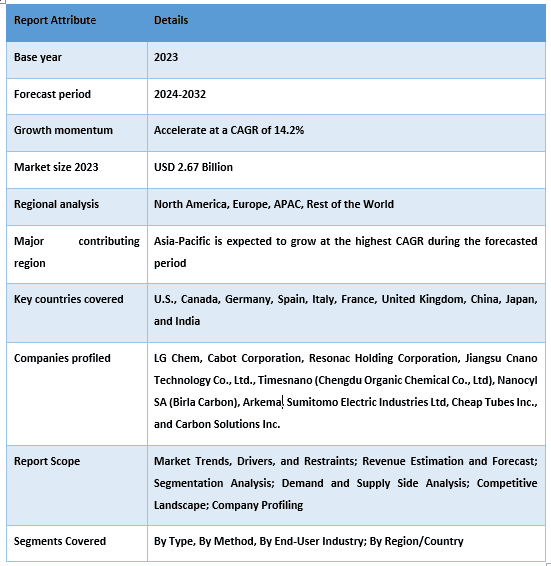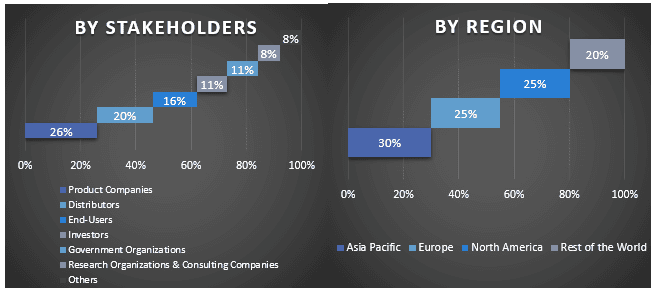- Home
- About Us
- Industry
- Services
- Reading
- Contact Us
Carbon Nanotubes (CNT) Market: Current Analysis and Forecast (2024-2032)
Emphasis on Type (Single-Walled Carbon Nanotubes, Multi-Walled Carbon Nanotubes); Method (Physical, Chemical, Others); By End-Use Industry (Electronics and Semiconductors, Energy and Storage, Structural Composites, Chemical Material and Process, Medical, and Others), Region/Country.

Carbon Nanotubes (CNT) Market Size & Forecast
The Carbon Nanotubes (CNT) Market was valued at USD 2.67 Billion in 2023 and is expected to grow at a strong CAGR of around 14.2% during the forecast period (2024-2032) owing to the growing demand for lightweight materials, growing use of nanotubes in aerospace and automotive industries, etc.
Carbon Nanotubes (CNT) Market Analysis
The requirement for advanced materials, particularly in the electronics, automotive, aerospace, energy, and well-being industries, is the primary factor driving the demand for Carbon Nanotubes (CNT) in the international market. These give extraordinary mechanical, electrical as well as thermal properties in various applications, enhancing the efficiency or performance of batteries, sensors, lighter composites, and drug delivery systems. The growing phenomenon of sustainability and energy-efficient technologies is propelling the market, especially with respect to the electric vehicle (EV) and renewable energy industries. The aerospace and automotive industries are also using more CNTs with these goals in mind-strengthening while reducing weight and improving fuel efficiency. The high thrusts being put into R&D for new CNT applications also speed up development in favor of this market. Emerging economies, especially China, India, and South Korea, effectively account for the carbon nanotube market's needs, as these areas have seen speedy industrialization, developments in infrastructure, and advancements in technology.
Rising demands for lightweight materials which are driving industries specifically aerospace, automotive, and manufacturing. The increasing environmental concerns among the global community and the ever-increasing need for energy efficiency are some of the factors prompting the adoption of lighter and stronger materials to become cost-efficient in fuel consumption and emissions and improving performance besides being lighter. Lightweight materials also improve the fuel efficiency of automobiles since it reduces the total weight of vehicles, resulting in lower greenhouse gas emissions and higher mileage. Application of Carbon Nanotubes (CNT) (CNTs) with high strength-to-weight ratio assumes increasing significance in such applications as it can provide mechanical properties superior to those offered by traditional materials like steel and aluminum but with significantly lower weight. Considering the demand for such materials in different industries the Carbon Nanotubes (CNT) market is further anticipated to grow during 2024-2032.
Carbon Nanotubes (CNT) Market Trends
This section discusses the key market trends that are influencing the various segments of the Carbon Nanotubes (CNT) market as identified by our team of research experts.
Growing Use in Automotive and Aerospace Sectors
The global CNTs market is booming due to applications mainly orchestrated with growing demands in both these sectors of automotive and aerospace industries. These Carbon Nanotubes (CNT) are being applied in the automotive industries into lightweight and high-strength materials which are meant to improve vehicle performance, fuel efficiency, and safety. Thanks to the superior mechanical, electrical, and thermal properties of these materials, CNTs can be used to manufacture parts like body panels, batteries, and sensors. In aerospace, CNT production forms stronger, lighter materials, thus improving aircraft efficiency and durability. This demand in these sectors is greatly attributed to increased sustainability that CNTs provide both concerning emissions and energy consumption in these sectors. As such trends are likely to continue along with innovations, they will also lead to incremental expansion at market level.

Asia Pacific is Expected to Grow with Significant CAGR During Forecast Period
The Carbon Nanotubes (CNT) (CNTs) market globally is estimated to be led by the APAC region, which has rapidly industrialized itself and advanced in technology, as the major manufacturers are also situated in places such as China, Japan, and South Korea. Major hubs for different industries, such as electronics, automotive, aerospace, and energy, are all heavily relying on CNTs. Some of the reasons attributed to CNT adoption in the Asian region include growing levels of use in applications such as semiconductors, energy storage systems, lightweight composites, and drug delivery systems. Increasing demand for adoption of electric vehicles (EVs), modules of renewable energy technologies such as solar power and energy storage also drives CNT consumption. All public initiatives put in place in a good R&D environment are the pillars of the region to maintain a lead in CNTs production and innovation. The APAC carbon nanotube market will continually record strong growth and a large market share with industrial expansion and technological progress.

Carbon Nanotubes (CNT) Industry Overview
The Carbon Nanotubes (CNT) market is competitive and fragmented, with the presence of several global and international market players. The key players are adopting different growth strategies to enhance their market presence, such as partnerships, agreements, collaborations, new product launches, geographical expansions, and mergers and acquisitions. Some of the major players operating in the market include LG Chem, Cabot Corporation, Resonac Holding Corporation, Jiangsu Cnano Technology Co., Ltd., Timesnano (Chengdu Organic Chemical Co., Ltd), Nanocyl SA (Birla Carbon), Arkema, Sumitomo Electric Industries Ltd, Cheap Tubes Inc., and Carbon Solutions Inc.
Carbon Nanotubes (CNT) Market News
In 2024, a research team in the Department of Energy and Chemical Engineering at UNIST unveiled an innovative technology for the conversion of waste plastics into carbon nanotubes (CNTs). It is a high-value material that plays a critical role in achieving carbon neutrality and promoting a circular economy and help recyclability.
Carbon Nanotubes (CNT) Market Report Coverage

Reasons to buy this report:
- The study includes market sizing and forecasting analysis validated by authenticated key industry experts.
- The report presents a quick review of overall industry performance at one glance.
- The report covers an in-depth analysis of prominent industry peers with a primary focus on key business financials, product portfolios, expansion strategies, and recent developments.
- Detailed examination of drivers, restraints, key trends, and opportunities prevailing in the industry.
- The study comprehensively covers the market across different segments.
- Deep dive regional level analysis of the industry.
Customization Options:
The global Carbon Nanotubes (CNT) market can further be customized as per the requirement or any other market segment. Besides this, UMI understands that you may have your own business needs, hence feel free to contact us to get a report that completely suits your requirements.
Table of Content
Research Methodology for the Carbon Nanotubes (CNT) Market Analysis (2024-2032)
Analyzing the historical market, estimating the current market, and forecasting the future market of global Carbon Nanotubes (CNT) were the three major steps undertaken to create and explore the adoption of Carbon Nanotubes (CNT) in major regions globally. Exhaustive secondary research was conducted to collect the historical market numbers and estimate the current market size. Secondly, numerous findings and assumptions were taken into consideration to validate these insights. Moreover, exhaustive primary interviews were also conducted with industry experts across the value chain of the global Carbon Nanotubes (CNT) market. Post assumption and validation of market numbers through primary interviews, we employed a top-down/bottom-up approach to forecasting the complete market size. Thereafter, market breakdown and data triangulation methods were adopted to estimate and analyze the market size of segments and sub-segments of the industry. Detailed methodology is explained below:
Analysis of Historical Market Size
Step 1: In-Depth Study of Secondary Sources:
A detailed secondary study was conducted to obtain the historical market size of Carbon Nanotubes (CNT) through company internal sources such as annual reports & financial statements, performance presentations, press releases, etc., and external sources including journals, news & articles, government publications, competitor publications, sector reports, third-party database, and other credible publications.
Step 2: Market Segmentation:
After obtaining the historical market size of Carbon Nanotubes (CNT), we conducted a detailed secondary analysis to gather historical market insights and share for different segments and sub-segments for major regions. Major segments are included in the report, such as by type, by method and by end-user industry. Further country-level analyses were conducted to evaluate the overall adoption of testing models in that region.
Step 3: Factor Analysis:
After acquiring the historical market size of different segments and sub-segments, we conducted a detailed factor analysis to estimate the current market size of Carbon Nanotubes (CNT). Further, we conducted factor analysis using dependent and independent variables such as by type, by method and by end-user industry of Carbon Nanotubes (CNT) market. A thorough analysis was conducted of demand and supply-side scenarios considering top partnerships, mergers and acquisitions, business expansion, and product launches in the Carbon Nanotubes (CNT) sector across the globe.
Current Market Size Estimate & Forecast
Current Market Sizing: Based on actionable insights from the above 3 steps, we arrived at the current market size, key players in the global Carbon Nanotubes (CNT) market, and market shares of the segments. All the required percentage shares split, and market breakdowns were determined using the above-mentioned secondary approach and were verified through primary interviews.
Estimation & Forecasting: For market estimation and forecast, weights were assigned to different factors including drivers & trends, restraints, and opportunities available for the stakeholders. After analyzing these factors, relevant forecasting techniques i.e., the top-down/bottom-up approach were applied to arrive at the market forecast for 2032 for different segments and sub-segments across the major markets globally. The research methodology adopted to estimate the market size encompasses:
- The industry’s market size, in terms of revenue (USD) and the adoption rate of the Carbon Nanotubes (CNT) across the major markets domestically
- All percentage shares, splits, and breakdowns of market segments and sub-segments
- Key players in the global Carbon Nanotubes (CNT) market in terms of products offered. Also, the growth strategies adopted by these players to compete in the fast-growing market
Market Size and Share Validation
Primary Research: In-depth interviews were conducted with the Key Opinion Leaders (KOLs) including Top Level Executives (CXO/VPs, Sales Head, Marketing Head, Operational Head, Regional Head, Country Head, etc.) across major regions. Primary research findings were then summarized, and statistical analysis was performed to prove the stated hypothesis. Inputs from primary research were consolidated with secondary findings, hence turning information into actionable insights.
Split of Primary Participants in Different Regions

Market Engineering
The data triangulation technique was employed to complete the overall market estimation and to arrive at precise statistical numbers for each segment and sub-segment of the global Carbon Nanotubes (CNT) market. Data was split into several segments & sub-segments post studying various parameters and trends in the areas by type, by method and by end-user industry in the global Carbon Nanotubes (CNT) market.
The main objective of the Global Carbon Nanotubes (CNT) Market Study
The current & future market trends of the global Carbon Nanotubes (CNT) market were pinpointed in the study. Investors can gain strategic insights to base their discretion for investments on the qualitative and quantitative analysis performed in the study. Current and future market trends determined the overall attractiveness of the market at a regional level, providing a platform for the industrial participant to exploit the untapped market to benefit from a first-mover advantage. Other quantitative goals of the studies include:
- Analyze the current and forecast market size of Carbon Nanotubes (CNT) industry in terms of value (USD). Also, analyze the current and forecast market size of different segments and sub-segments
- Segments in the study include areas by type, by method and by end-user industry
- Define and analysis of the regulatory framework for the Carbon Nanotubes (CNT) industry
- Analyze the value chain involved with the presence of various intermediaries, along with analyzing customer and competitor behaviors of the industry
- Analyze the current and forecast market size of the Carbon Nanotubes (CNT) market for the major region
- Major countries of regions studied in the report include Asia Pacific, Europe, North America, and the Rest of the World
- Company profiles of the Carbon Nanotubes (CNT) market and the growth strategies adopted by the market players to sustain in the fast-growing market
- Deep dive regional level analysis of the industry
Frequently Asked Questions FAQs
Q1: What is the current market size and growth potential of the Carbon Nanotubes (CNT) market?
Ans: The Carbon Nanotubes (CNT) Market was valued at USD 2.67 Billion in 2023 and is expected to grow at a strong CAGR of around 14.2% during the forecast period (2024-2032).
Q2: What are the driving factors for the growth of the Carbon Nanotubes (CNT) market?
Ans: The growing demand for lightweight materials from industries as aerospace, automotive, energy sector, etc., are some of the key factors attributing to the market growth.
Q3: Which segment has the largest share in the Carbon Nanotubes (CNT) market by Type?
Ans: The Multi-Walled Carbon Nanotubes (CNT) has the largest share of the Carbon Nanotubes (CNT) market by Type.
Q4: What are the emerging technologies and trends in the Carbon Nanotubes (CNT) market?
Ans: Expansion of CNT in healthcare sector and development of cost effective production methods are some of the key trends observed in the Carbon Nanotubes (CNT) market.
Q5: Which region will dominate in the Carbon Nanotubes (CNT) market?
Ans: Asia Pacific is expected to dominate the market during the forecast period.
Related Reports
Customers who bought this item also bought










